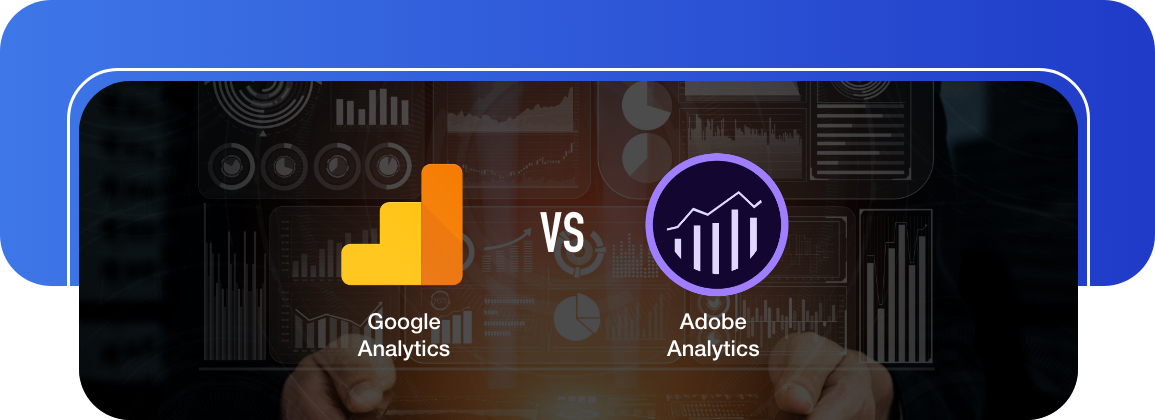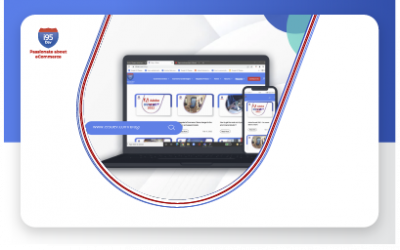Adobe analytics VS Google analytics
– Which is better for eCommerce?

With the exception of gauging web traffic, web analytics have a significant role to play in executing e-commerce market research and assessing how a website and web store is performing. Talking in business terms, it gives you an in-depth analysis that helps you determine whether your online business is giving you a decent return on your investment and bags future prospects for better revenue generation.
Every eCommerce business has different data requirements, thus, the analytics tool they make use of is dissimilar. A web analytics tool that serves your purpose perfectly is the one you should go for. This will help you acquire insightful analytics data that will guide you to make the right decisions for constant growth in times ahead.
A few of the web analytics tools stand out as they are pitch-perfect in their make, insights, and accuracy. One of the renowned names is Google Analytics. It is an extremely powerful software that is available for you free of cost. The Google analytics offers an intuitive user interface, daily web traffic analysis, identification of traffic sources, identification of keyword research done by visitors, commendable engagement metrics along with a grip on conversions and conversion rates. Such an in-depth analysis of data gives you a sharp insight into customer behavior that helps you shoot your profits multitudinously. However, when it is about E-commerce websites, there is just one web analytic software that surpasses Google Analytics and steals the show – Adobe Analytics!
Benefits of Adobe Analytics:
- Third-party integration support – Adobe Analytics has a sharply defined benefit as far as third party integration support is concerned. It flaunts a broad range of connectors for integrating with various types of the third party and Adobe tools. You have the option of importing and exporting data automatically. The export data will help you measure things like cart abandonments while the import data will give you an idea of the email metrics such as clicks, opens, and bounces. You can make use of this data for efficient remarketing. On the other hand, Google Analytics lacks this feature diversely. It faces severe challenges while connecting with third-party tools, however, data can be brought in through measurement protocol API. Thus, it will not be a one-click integration, unlike Adobe Analytics.
- Customer support and account management – Adobe Analytics provides you round the clock customer support and account management. In addition, it offers countless research papers, tutorials, and videos having solutions to technical problems. All of it for free! On the other hand, Google Analytics does not provide any chat or support line for resolving customer complaints. Therefore, the customer experience with Adobe Analytics is way more superior to Google Analytics.
- Data storage ability – For their licensed customers and clients, Adobe Analytics allows you to store data for an unlimited span of time. On the other hand, Google Analytics gives you the option of storing data for merely 2 years. In addition, Adobe Analytics stores cookies for 15 years while Google Analytics stores cookies for merely 30 days. This makes it easy for Adobe to save visit information and customer preferences.
- Custom Variables and Metrics – Adobe Analytics has the advantage of being extremely customizable. You can create custom events, traffic, and conversion variables. It offers specific information on individual visitors that greatly helps in identifying potential customers such as who clicked on a certain campaign or who bought a product. It allows 75 traffic variables and 100 conversion variables, along with 1000 success event metrics. On the other hand, Google Analytics merely allows 20 custom metrics and 20 custom dimensions.
- Pathing and Funnels – Pathing is the sequence or order of pages visited by your website users. Pathing is flexible and commendable in Adobe Analytics. In addition, Adobe analytics flaunts custom event funnels against valuable historical data. A funnel is a navigation path that you anticipate your visitors to follow for acquiring website goals. With the help of funnels, you can eradicate bottlenecks in your sales or conversion process. Talking about pathing in Google Analytics – it is atrocious! The Page Navigation Summary report works fine when you just want to see the next page or the earlier one, however, you will not be able to go beyond it. In addition, the funnels are outdated and need immediate modification. An industry expert from Analytics Demystified stated that “Adobe Analytics has a long-standing history of extensive custom variables, the ability to do pathing on those variables pops up as being super handy when you’d least expect it.”
- Hits and Goals – Adobe Analytics captures endless hits per month while Google Analytics is restricted to 10 million hits every month. What’s more, you are able to track 100 goals on Adobe Analytics while merely 4 goals can be tracked on Google Analytics. Goals provide critical information such as the sales conversion rates for your website or the total number of sales conversions.
Conclusion
If a website witnesses a high number of variables and high web traffic, Adobe Analytics is ideal for it. To put it bluntly, mostly such sites are e-commerce websites that demand extensive custom coding so that correct values swim smoothly through an online checkout process. Adobe Analytics offers seamless integration with third-party tools which is extremely beneficial for e-commerce websites as they engage with third-party vendors and take up paid marketing initiatives on a regular basis.
An industry expert who has umpteen years of experience in managing and consulting hundreds of online marketing companies and websites with millions of visitors every month and who is a former head of marketing at KISSmetrics stated – “At the e-commerce level, Adobe Analytics is the de facto winner. If my goal were to seriously up-level my analytics capabilities beyond Google Analytics, I’d go with Adobe Analytics. It’s a more complete analytics package that extends beyond the website-only focus of Google Analytics.”
Recent Blogs
Enhancing Shipping Precision with Custom Shipping Groups in Adobe Commerce/ Magento
Enhancing Shipping Precision with Custom Shipping Groups in Adobe Commerce/ Magento Author Category Share Three things matter the most when it comes to eCommerce shipping: speed, accuracy,...
Managing Massive Product Catalogs: Why Synchronization is the Key to Efficiency
Managing Massive Product Catalogs: Why Synchronization is the Key to Efficiency Author Category Share The automotive aftermarket industry is vast and highly competitive, requiring businesses...
A Complete Guide to Seamlessly Integrating Adobe Commerce with NetSuite
A Complete Guide to Seamlessly Integrating Adobe Commerce with NetSuite Author Category Share Integrating Adobe Commerce (formerly Magento) with NetSuite ERP can transform the way businesses...



